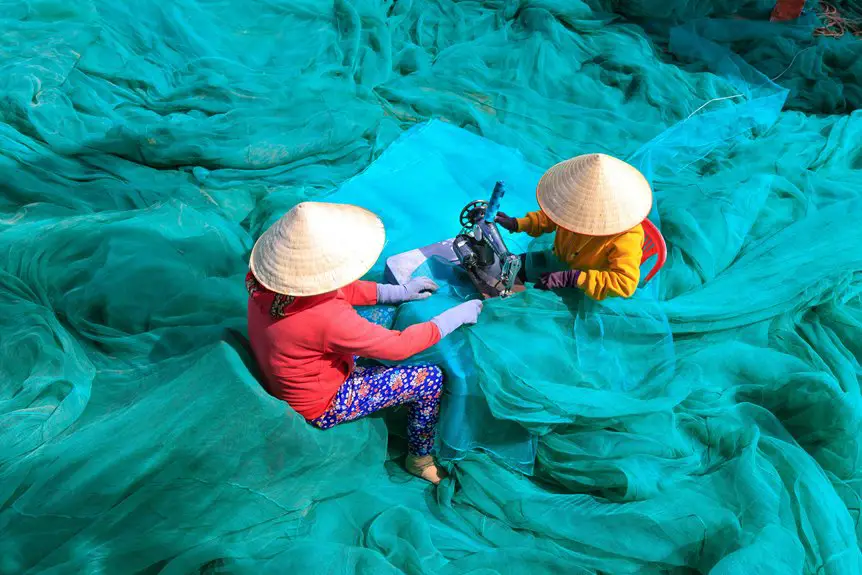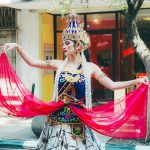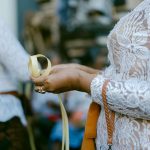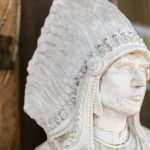You’ll find Indonesian Ikat is a vibrant tradition where skilled artisans tie and dye threads to create intricate patterns, each telling a unique cultural story. Across islands like Bali, Sumba, and Flores, distinct designs and symbolism reflect local identity, spirituality, and social status. Ikat remains essential in ceremonies and modern fashion, blending heritage with innovation. Explore this rich textile art further, and you’ll uncover even more fascinating stories woven into every thread.
Table of Contents
Key Takeaways
- Indonesian Ikat is a traditional textile art reflecting diverse ethnic cultures and centuries of history across the islands.
- The resist dyeing technique involves tying yarns before dyeing to create intricate, symbolic patterns unique to each region.
- Regional Ikat styles vary, with Bali’s bright colors, Sumba’s geometric designs, Flores’ delicate patterns, and Kalimantan’s animal motifs.
- Ikat patterns symbolize spirituality, social status, and nature, conveying cultural identity and stories through colors and motifs.
- Contemporary Ikat blends tradition with modern design, using sustainable materials and supporting artisan communities.
Origins and History of Ikat in Indonesia
The origins of Ikat in Indonesia trace back centuries, rooted deeply in the archipelago’s diverse cultures. When you explore Ikat’s history, you’ll find it reflects the rich traditions of various ethnic groups, each adding unique patterns and meanings.
You’ll notice that Ikat was more than just fabric; it symbolized social status, spirituality, and local identity. As trade routes expanded, Ikat evolved by absorbing influences from India, China, and the Middle East, yet maintained its distinct Indonesian character.
You might be surprised how this textile art became an essential part of ceremonies and daily life alike. By understanding Ikat’s origins, you appreciate not only its beauty but also how it connects you to Indonesia’s cultural heritage and the hands that crafted it through time.
Traditional Ikat Weaving Techniques
To truly appreciate Indonesian Ikat, you need to understand how artisans create its intricate patterns.
First, they carefully tie sections of the yarn with tight bindings before dyeing, a technique called resist dyeing. This process controls which parts absorb color, forming the design. After dyeing, the bindings are removed, revealing patterns on the threads.
You’ll find that the yarns are then aligned precisely on a loom to weave the final fabric, ensuring the dyed motifs match perfectly. This method demands patience and skill, as mistakes can ruin the design.
Regional Variations Across Indonesian Islands
When you explore Indonesian Ikat textiles, you’ll notice each island brings its own unique flair to the craft.
These regional variations reflect local culture, climate, and history, making every piece a vivid story.
For example:
- Bali’s Ikat dazzles with bright colors and intricate motifs that capture the island’s spiritual vibrancy.
- Sumba’s textiles are known for bold geometric designs and earthy tones, echoing its rugged landscapes.
- Flores offers softer hues and delicate patterns, showcasing refined weaving techniques.
- Kalimantan’s Dayak Ikat features striking contrasts and symbolic animal motifs tied to ancestral beliefs.
Symbolism and Meaning in Ikat Patterns
Each island’s unique Ikat style carries layers of meaning woven into its patterns. When you look closely, you’ll see symbols representing nature, spirituality, and social status.
For example, certain motifs might depict animals or plants sacred to the local culture, reflecting beliefs and respect for the environment. Other designs convey messages about the wearer’s identity, like their community or rank.
Colors also play a significant role; deep reds or blacks often symbolize strength or protection, while lighter shades can represent purity or peace.
The Role of Ikat in Indonesian Ceremonies
Although you might see Ikat textiles as beautiful art, they play an essential role in Indonesian ceremonies that go far beyond decoration.
Ikat is woven into the very fabric of cultural identity and spiritual life. When you witness a ceremony, you’ll notice Ikat’s significance in:
- Marking important life events like weddings and births, symbolizing unity and blessings.
- Serving as sacred offerings to ancestors, connecting the living with their heritage.
- Denoting social status and community roles through distinct patterns and colors.
- Enhancing ritual performances, where wearing Ikat invokes protection and respect.
You’ll quickly realize that Ikat isn’t just cloth—it’s a living tradition, carrying stories and spirituality in every thread during these ceremonies.
Modern Adaptations and Contemporary Ikat Art
You’ll find that modern Ikat designs blend traditional techniques with fresh, innovative patterns that catch the eye.
Ikat’s influence has expanded beyond textiles into the world of fashion, where designers incorporate its unique style into contemporary clothing.
Let’s explore how these adaptations keep Ikat vibrant and relevant today.
Innovative Ikat Designs
When designers blend traditional ikat techniques with modern aesthetics, they create innovative textiles that resonate with today’s fashion and art scenes.
You’ll find these contemporary ikat designs breaking boundaries by:
- Incorporating bold, abstract patterns that challenge conventional motifs.
- Experimenting with unexpected color palettes, from neon brights to muted pastels.
- Using sustainable materials and eco-friendly dyes to honor heritage while protecting the planet.
- Collaborating with digital artists to produce ikat-inspired prints for mixed media projects.
Ikat in Fashion
Ikat’s rich patterns and vibrant colors have found a fresh place in modern fashion, where designers reimagine traditional weaving for contemporary wardrobes.
When you wear Ikat-inspired pieces, you’re embracing a blend of cultural heritage and cutting-edge style. Designers incorporate Ikat motifs into dresses, jackets, scarves, and accessories, making these timeless patterns accessible and trendy.
You’ll notice how artisans combine traditional dyeing techniques with modern fabrics, creating unique textures and sustainable fashion choices. By choosing Ikat fashion, you support artisans preserving this craft while adding bold, meaningful designs to your closet.
Whether you prefer subtle accents or statement pieces, Ikat’s versatility lets you express individuality while celebrating Indonesian artistry. It’s fashion that connects past and present beautifully.
Preservation Efforts and Cultural Significance
You can see how community-led conservation initiatives play a vital role in keeping Ikat traditions alive.
These efforts help protect the unique techniques and stories woven into each piece.
Understanding the symbolism in Ikat designs reveals the deep cultural meanings behind the patterns you admire.
Community-led Conservation Initiatives
Although preserving traditional crafts can be challenging, communities across Indonesia have taken the lead in safeguarding ikat textiles.
You’ll find grassroots groups, artisans, and local leaders working together to keep these traditions alive. They’ve launched initiatives that:
- Teach younger generations weaving techniques to guarantee skills don’t vanish.
- Organize cultural festivals celebrating ikat’s heritage, drawing pride and attention.
- Collaborate with designers to innovate while respecting tradition, boosting ikat’s market value.
- Advocate for legal protections that recognize ikat’s cultural importance.
Symbolism in Ikat Designs
When you explore ikat textiles, you’ll notice each pattern carries deep cultural meanings that go beyond mere decoration. These designs symbolize social status, spiritual beliefs, and ancestral stories, preserving traditions across generations. Understanding these symbols helps you appreciate the ikat’s role in identity and heritage.
| Symbol | Meaning | Region |
|---|---|---|
| Dragon | Power, protection | Flores |
| Tree of Life | Growth, harmony | Sumba |
| Geometric | Unity, balance | Bali |
How to Identify Authentic Indonesian Ikat Textiles
How can you distinguish a genuine Indonesian ikat textile from a mass-produced imitation? Start by closely examining the fabric’s texture and dye quality. Authentic ikat is handwoven with natural fibers, giving it a unique, slightly uneven texture and vibrant, rich colors.
Distinguish genuine Indonesian ikat by its handwoven texture and vibrant, rich colors from natural fibers.
Here’s how to spot the real deal:
- Look for slight irregularities in the patterns—these imperfections show the hand-dyeing process.
- Check the edges; authentic ikat often has unfinished or frayed ends, unlike machine-made textiles.
- Feel the fabric—a genuine ikat feels soft but sturdy, not stiff or synthetic.
- Research provenance; genuine ikat usually comes with information about the weaver or region.
Trust your senses and knowledge to appreciate ikat’s true artistry.
Frequently Asked Questions
What Types of Dyes Are Used in Indonesian Ikat Textiles?
You’ll find natural dyes like indigo, turmeric, and sappanwood used in ikat textiles. These vibrant colors come from plants, roots, and bark, giving each fabric its unique, rich, and traditional appearance you’ll appreciate.
How Long Does It Take to Complete an Ikat Piece?
Like painting a masterpiece stroke by stroke, completing an ikat piece can take weeks to months. You’ll patiently tie, dye, and weave intricate patterns, knowing each step brings you closer to textile perfection.
Can Ikat Fabrics Be Machine Washed or Require Special Care?
You shouldn’t machine wash ikat fabrics since the delicate dyes and fibers can bleed or weaken. Instead, hand wash them gently in cold water with mild detergent to keep the colors vibrant and the fabric intact.
Are There Specific Tools Unique to Indonesian Ikat Weaving?
You’ll find specific tools like backstrap looms and tying instruments unique to ikat weaving. These tools help you create intricate patterns by binding threads before dyeing, making the process both precise and traditional.
How Can Tourists Respectfully Purchase Ikat Textiles in Indonesia?
You should buy directly from local artisans or reputable cooperatives to support communities. Always ask about the textile’s origin, avoid mass-produced copies, and respect cultural significance by learning the story behind each ikat piece before purchasing.
- Jaclyn Smith Fabric Coconut: a Review of This Rayon/Polyester Blend - June 29, 2025
- Jaclyn Smith Fabric Coconut: a Review of This Rayon/Polyester Blend - June 29, 2025
- How to Get Coconut Oil off Fabric Without Washing - June 29, 2025







